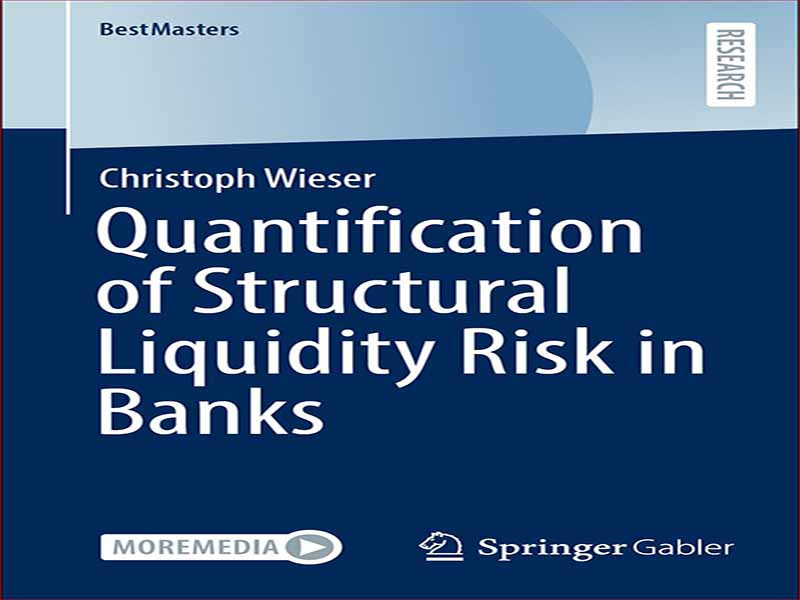- عنوان کتاب: Quantification of Structural Liquidity Risk in Banks
- نویسنده: Christoph Wieser
- حوزه: بانکی, مخاطرات مالی
- سال انتشار: 2022
- تعداد صفحه: 75
- زبان اصلی: انگلیسی
- نوع فایل: pdf
- حجم فایل: 1.07 مگابایت
بر اساس ستون 2 توافقنامه بازل، ارزیابی و تعیین کمیت همه خطرات با اهمیت مورد نیاز است. فرآیند مربوطه، فرآیند ارزیابی کفایت سرمایه داخلی (ICAAP) نامیده می شود و میزان ظرفیت تحمل ریسک مورد نیاز موسسه مالی را تعیین می کند. ریسک ساختاری نقدینگی یک ریسک بااهمیت است که از کسب و کار اصلی بانکی ناشی از اخذ سپردههای کوتاهمدت و اعطای وامهای بلندمدت، در نتیجه عدم تطابق سررسید بین داراییها و بدهیها ایجاد میشود. در برخی مواقع وام های بلندمدت نیاز به تامین مالی مجدد دارند و موسسه در معرض خطر توسعه نامطلوب هزینه های تامین مالی مجدد قرار دارد. این پایان نامه مدلی را برای کمی سازی ریسک ساختاری نقدینگی پیشنهاد می کند. اسپرد اعتبار موسسه به عنوان تنها منبع ریسک شناسایی شده و توسعه آتی آن با استفاده از شبیهسازی مونت کارلو مدلسازی شده است. فرآیند زیربنایی تکامل گسترش اعتبار یک فرآیند پرش- انتشار است. 99.9 درصد توزیع شبیه سازی شده مقادیر پایانه به نرخ های سوآپ اضافه می شود تا هزینه های تامین مالی مجدد را نشان دهد. تغییر در ارزش فعلی بین بسته شدن موقعیتهای نقدینگی باز تحت هزینههای تامین مالی مجدد تحت فشار در مقایسه با هزینههای جاری، تاثیر محاسبهشده بر ظرفیت تحمل ریسک است. مدل پیشنهادی مبنایی را برای یک مدل پیچیدهتر برای تعیین کمیت ریسک نقدینگی ساختاری با کاهش نقاط ضعف شناسایی شده و اجرای بهبودهای پیشنهادی فراهم میکند.
Under Pillar 2 of the Basel Accords an assessment and quantification of all material risks is required. The corresponding process is called Internal Capital Adequacy Assessment Process (ICAAP) and it determines the amount of riskbearing capacity the financial institution requires. Structural liquidity risk is a material risk resulting from the core banking business of taking in short-term deposits and lending out long-term loans, thus allowing a maturity mismatch between assets and liabilities. At some point the long-term loans will require refinancing and the institution is at risk of an adverse development of refinancing costs. This thesis proposes a model for the quantification of structural liquidity risk. The institution’s credit spread is identified as sole source of risk and its future development is modelled using Monte Carlo simulation. The underlying process of the credit spread evolution is a jump-diffusion process. The 99.9% quantile of the simulated distribution of terminal values is added on top of the swap rates to represent the stressed refinancing costs. The change in present value between closing open liquidity positions under stressed refinancing costs compared to current costs is the calculated impact on risk-bearing capacity. The proposed model provides the basis for a more sophisticated model to quantify structural liquidity risk by mitigating identified weaknesses and implementing suggested improvements.
این کتاب را میتوانید از لینک زیر بصورت رایگان دانلود کنید:
Download: Quantification of Structural Liquidity Risk in Banks



































نظرات کاربران